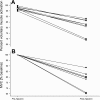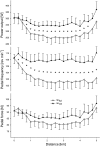Somatosensory feedback from the limbs exerts inhibitory influences on central neural drive during whole body endurance exercise
- PMID: 18787091
- PMCID: PMC2612475
- DOI: 10.1152/japplphysiol.90456.2008
Somatosensory feedback from the limbs exerts inhibitory influences on central neural drive during whole body endurance exercise
Abstract
We investigated whether somatosensory feedback from contracting limb muscles exerts an inhibitory influence on the determination of central command during closed-loop cycling exercise in which the subject voluntarily determines his second-by-second central motor drive. Eight trained cyclists performed two 5-km time trials either without (5K(Ctrl)) or with lumbar epidural anesthesia (5K(Epi); 24 ml of 0.5% lidocaine, vertebral interspace L(3)-L(4)). Percent voluntary quadriceps muscle activation was determined at rest using a superimposed twitch technique. Epidural lidocaine reduced pretime trial maximal voluntary quadriceps strength (553 +/- 45 N) by 22 +/- 3%. Percent voluntary quadriceps activation was also reduced from 97 +/- 1% to 81 +/- 3% via epidural lidocaine, and this was unchanged following the 5K(Epi), indicating the presence of a sustained level of neural impairment throughout the trial. Power output was reduced by 9 +/- 2% throughout the race (P < 0.05). We found three types of significant effects of epidural lidocaine that supported a substantial role for somatosensory feedback from the exercising limbs as a determinant of central command throughout high-intensity closed-loop cycling exercise: 1) significantly increased relative integrated EMG of the vastus lateralis; 2) similar pedal forces despite the reduced number of fast-twitch muscle fibers available for activation; 3) and increased ventilation out of proportion to a reduced carbon dioxide production and heart rate and increased blood pressure out of proportion to power output and oxygen consumption. These findings demonstrate the inhibitory influence of somatosensory feedback from contracting locomotor muscles on the conscious and/or subconscious determination of the magnitude of central motor drive during high intensity closed-loop endurance exercise.
Figures




References
-
- Adreani CM, Hill JM, Kaufman MP. Responses of group III and IV muscle afferents to dynamic exercise. J Appl Physiol 82: 1811–1817, 1997. - PubMed
-
- Amann M, Calbet JA. Convective oxygen transport and fatigue. J Appl Physiol 104: 861–870, 2008. - PubMed
-
- Amann M, Hopkins WG, Marcora SM. Similar sensitivity of time to exhaustion and time trial to changes in endurance. Med Sci Sports Exerc 40: 574–578, 2008. - PubMed
Publication types
MeSH terms
Substances
Grants and funding
LinkOut - more resources
Full Text Sources
Medical

